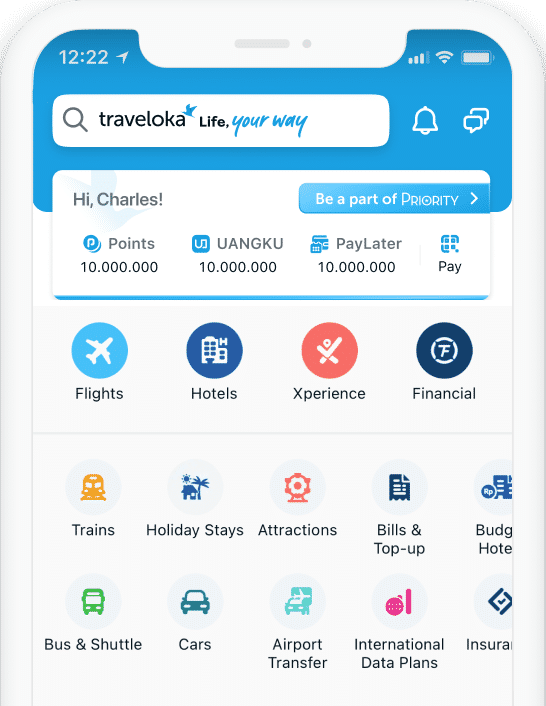
Hotels in Pak Chong
- Hotel/
- Thailand(32672 Hotels)/
- Nakhon Ratchasima(840 Hotels)/
- Khao Yai(607 Hotels)/
- Pak Chong(103 Hotels)

Why Pay More
When You Can Pay Less?

Popular Hotels in Pak Chong
Discover what you like
Stay near exciting spots
Plenty of options, whatever your occasion
ลงทะเบียนเพื่อใช้คูปองของคุณเลย
ส่วนลดเที่ยวบิน
ส่วนลดโรงแรม
ส่วนลดที่เที่ยวและกิจกรรม
ส่วนลดบริการเช่ารถ
ส่วนลดบริการรับส่งสนามบิน
More about Pak Chong
Introduction

Pak Chong is the westernmost district of the Nakhon Ratchasima province. It is known as the district that’s the entrance to Khao Yai National Park. It is the gateway to the Isan (northeast) region of Thailand. The connecting pass is the Sankamphaeng Range mountain area in the southern region of this district. Within Khao Yai National Park is the Takhong River, a tributary of the Mun River. The Takhong River is the main water source of Nakhon Ratchasima city.
Not a particularly populated area of Thailand, its proximity to Bangkok make it a popular destination for wealthy Thais to own their vacation homes. It’s a great place to escape and breathe in some fresh air, and all within a two hour drive from Bangkok.
The best times to visit Pak Chong and Khao Yai National Park are during the cool season between November and January, as well as the rainy season from May to November. During the cool season, it’s optimal to explore the park and go on treks and hikes since the chance of rain are low, and you’ll be less prone to getting heat exhaustion. However, during cool season, the waterfalls will not be as high as during rainy season.
The waterfalls are most impressive during October and November, towards the end of the rainy season since the rain has been collecting all season. However, during these times, the hikes and journey of getting to the top of waterfalls may be more treacherous. There are some good hiking paths in this region that are well marked, but many of them wash out and get slippery and muddy, so make sure to wear the proper shoes.
History
The area around Korat has been an important hub for trade and other military activities since the Khmer empire in the 11th century. Some of these ruins can be seen in Phimai Historical Park. This region still has a high population compared to other parts in Thailand of a Khmer population stemming back from these historical times.
In the late 19th century, Nakhon Ratchasima, the province that Pak Chong is located in, was the most important political and economic center in the Isan or Northeastern region. The railroad was an important aspect of the history’s region in the 1930s, when a stronghold of the royalist troops in the Boworadej Revolt fought against the new democratic government in Bangkok. In the 1960s until mid 1970s, the region was occupied by the United States Air Force.
Surrounding Areas
Wang Nam Khiao
A town that’s privileged to have a cooler climate than most areas of Thailand, Wang Nam Khiao is home to several fruit orchards, waterfalls abound, as well as a layer of fog which keeps out the UV rays and makes the weather more tolerable.
Nakhon Nayok
A district that’s abundant with elephants, rice fields, and various fruit farms. The Nakhon Nayok River, located in Khao Yai National Park is a popular place to go river rafting in the rainier months. The best time to go is November when the weather is dry, but the river is flowing aplenty from the rainy season.
Prachantakham
The Sankamphaeng Range mountains dominate the northern section of this district, much of it under environmental protection. Illegal logging within the forested areas has been a major problem, as well as the smuggling of the Phayung (Siamese rosewood) trees. The mountain range is also home to the Sunda Pangolin, a small mammal with powerful claws that primarily feeds on ants and termites.
Hotels
There aren’t as many accommodation options in Pak Chong as in surrounding areas such as Bangkok, but since tourism in recent years has started to pick up, there are more and more options becoming available. Here are some of our favorites:
Rimtarninn Hotel
Located right on the river as well as on a main road with easy access to restaurants and nightlife, Rimtarinn Hotel also offers the additional service of car service. This is incredibly convenient since proper exploration of Pak Chong requires a motorized vehicle of some sorts, whether it’s a motorbike or a car. There’s a restaurant and bar on premise in the case that you don’t want to leave the hotel after a long day of exploring the great outdoors.
Hommuenlee Hill Resort
Walking distance of less than 1 kilometer from Thong Somboon Club, this spacious and beautiful resort is a relaxing and scenic place to relax. The restaurant serves up a wide variety of Thai and international specialities. Each villa has a LCD TV, kettle, mini fridge, hairdryer, two beds, complimentary tea and coffee, four free bottles of water daily, and each room has its own air conditioner controller for those who want different sleeping temperatures. There are a few different styles of villas at different price points, but the general atmosphere of this resort is high end resort but at mid range prices.
Kao Yai Panorama
Mentioned below in this article as an attraction for mushrooms, this is the resort for that farm. You’ll be staying on a sprawling farm filled with fresh vegetables, mushrooms, a shop, and a variety of animals. You’ll also be close to Chokchai Farms which also has a farm. You’ll definitely be eating and breathing well if you choose to stay in this area of Pak Chong! Each guest at Kao Yai Panorama has access to an outdoor pool, squash court, bar, cafe, and billiard facilities.
Transportation
The closest airport to Pak Chong is Bangkok’s Don Muaeng or Suvarnabhumi airports. Once you arrive to Bangkok, further instructions on how to get here are below.
By Train
Pak Chong has a train station on the northeastern line. Twelve trains depart daily from Bangkok, with a few overnight choices available. The trip takes about six hours, costing between 85 and 250 THB depending on the class of train you’re in.
By Bus
Buses depart every 30-40 minutes from Mo Chit North Terminal in Bangkok, and will cost you about 180 THB. Pak Chong can be accessed via Nakhon Ratchassima or Korat which are the main transit hubs to Isaan. Make sure that the driver is willing to drop you in Pak Chong, the drivers tend to be quite nice if you just let them know when you board that that’s where you want to be dropped off.
By Car
A much more comfortable and convenient way to head to Pak Chong is by car. The trip should take about 2.5 hours without traffic. There are a few different routes to get there, make sure that you check traffic on Google Maps to find the most efficient route. Sometimes there are closures for road fixtures which can add an hour or two to your commute time. In addition, since this is a popular destination for wealthy Thais on the weekends, make sure you leave before 2pm on Fridays to avoid the weekend traffic. Heading there on weekdays is best in terms of traffic.
Getting Around
The best way to explore the area is to rent your own wheels. Motorbikes can usually be rented for about 200-300 THB a day. Bikes are usually rented with an empty tank, so ask the renter where the nearest petrol station is. There are no petrol stations in Khao Yai National Park, so make sure you fill up prior to entering the park. An entire day’s exploration should be no more than one tank of gas unless you’re driving for the entire day without stopping. If you’re worried about running out of gas, you can always get a small container to take with you at the petrol station. Thais often store some reserve petrol in a Hong Thong (whiskey) bottle.
Attractions

Farm Chokchai
A theme park set on a farm, this attraction has something for everyone. Gaze out into the gorgeous, expansive land, buy some fresh yogurt and cream, or have lunch with freshly picked ingredients. You may choose to interact with the farm animals and milk the cows if you desire, kids love this! You can take a tour for 300 THB per adult and 150 THB per child which includes a free scoop of ice cream. Tours run every Tuesday - Friday from 10:00 until 14:00 on a fixed schedule, although if they’re incredibly busy there are usually enough guides around to offer tours every 20 minutes.
Opening hours: 10am to 10pm, this is for the farm overall. Different operations within the farm close at different hours, so be sure to call or check the website.
Entrance fee: none, although prices for tours are listed above.

Khao Yai National Park
Khao Yai National Park was established in 1962 and is the third largest national park in Thailand. It has been a UNESCO World Heritage Site since 2005. The park is home to many beautiful waterfalls, with Haew Narok Waterfall being the most popular, and one of the largest, especially during rainy season between May and November. It has three different levels that can be explored and climbed. You can see many wild animals such as monkeys and wild elephants if you’re lucky. Renting a motorbike or car is recommended for exploring this park, as there aren’t really taxi services within the park, and the park can be sparsely populated on the weekdays. There are some tours that will take you around in a songtaew (modified pickup truck), but this often reduces your chances of seeing wild animals, as the large vehicles are loud and can sometimes scare them away.
Opening hours: 8:00 to 17:00 daily.
Entrance fee: 400 THB for adults, 200 THB for children, car entrance fee is 50 THB.

GranMonte Vineyard
GranMonte Estate is in the Asoke Valley of Khao Yai, right near the national park. The Asoke VAlley is known for its yearly bloom of yellow blossoms. GranMonte, which translates into the “Big Mountain” is also the name of the national park, as Khao Yai directly translates into “big mountain” as well. This winery carries a few different kinds of wine, from shiraz to sauvignon. They offer a wine tasting as well as an educational tour, which has won the Tourism Authority of Thailand’s award for Agrotourism three years in a row.
Opening hours: 8am to 10pm, daily. Tours of the vineyard are available at 10:30am, 13:30, and 15:30 on weekends, and by appointment on weekdays.
Entrance fee: visiting the winery is free, but tours are 300 THB for adults and 220 THB for people under 20, and free for children under 5.
Facts about hotel in Pak Chong
Total Accommodation | 103 Properties |
Popular Hotel | 88 LIVING HOTEL, The Hill Hotel |
Popular Landmark | Chokchai Farm, Outlet village Khao Yai |
Frequently asked questions

Guest reviews in hotel near Pak Chong
Why book Accommodation in Traveloka?



We’ve got more than just hotels







































 Facebook
Facebook Instagram
Instagram TikTok
TikTok Youtube
Youtube Twitter
Twitter Line
Line